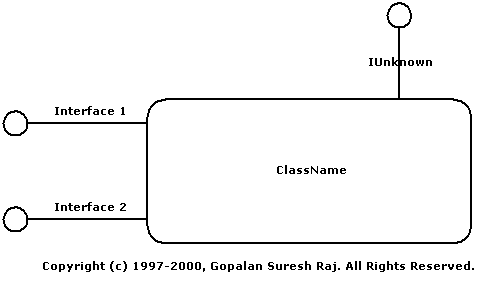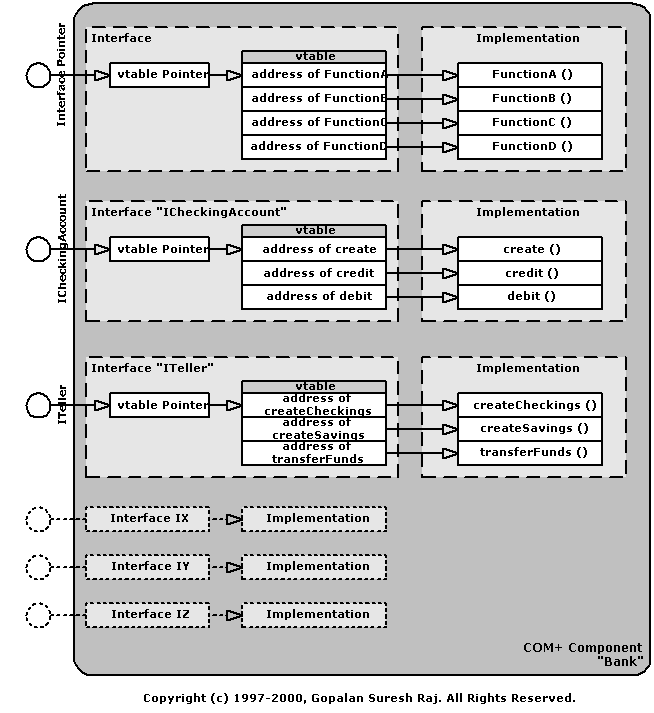COM+
Notation, Interface, and Implementation
Gopalan Suresh Raj
| Food for Thought... |
|
|
The COM+ component defines 'what' tasks it can
perform in terms of an Interface and 'how'
it performs it in terms of an Implementation. So
an interface is a contract between the component
and a client that a component agrees to satisfy and support. Each
functionality that a component provides to its clients will most
probably be represented using a distinct Interface.
Since many different types of components can expose the same
Interface, a COM interface is an Abstract Data Type (ADT) and
cannot be instantiated directly.
A COM Interface is a collection of semantically
related operations that express one functionality and focusses on
"what" the component can do.
However, a COM Implementation is a concrete instantiable data
type of COM. Every COM Implementation may expose one or more
interfaces and will have a name that is known to its client. COM
Implementations are often called COM Classes or coclasses.
A COM Implementation or COM Class
is an implementation of one or more interfaces and focusses on
"how" the component does what it does.
COM+ Notation
COM+ represents a component graphically using a floating opaque
box with a plug-in jack (also refered to as a 'lollipop')
extending to one side as shown in the following figure.

COM+ stresses binary
encapsulation. So it is only appropriate that COM+ components are
drawn as opaque boxes. In addition to simplifying client-side
documentation, this technique allows the component implementors
complete flexibility with respect to changing implementation
details. While this approach to documentation may be very useful
from the client-side perspective, it is however not very useful
to document how an object is implemented internally.
Also be aware that by convention, the names of all interfaces in
COM+, start with 'I'.
Interface
A COM+ Interface consists of a set of method definitions that are
usually related in the operations that they perform. Invoking a
method results in the execution of the COM+ object code
associated with that method. The method is usually invoked using
a pointer to the associated Interface.
For example, a "Bank" component can have interfaces
called ICheckingAccount and ITeller.
These interfaces generally group like methods. For example, the ICheckingAccount interface may contain methods called create(), credit(), and debit().
The ITeller interface may contain methods called createCheckingAccount(), createSavingsAccount(), and transferFunds().
The COM+ Interface is an Abstraction which contains the syntax of
the methods that it contains, and the semantics of how they are
to be used. The Interface has a very specific structure in that,
it is an array of pointers to the implementations of the methods
that it exposes.

Some Interesting
Observations
1. Notice that the vtable is actually an array
of function pointers. It is called a vtable since it represents
the same virtual table structure that C++
compilers produce when generating object code while compiling C++
classes.
2. Notice that the definition of an Interface does not include an
implementation of the interface methods. This separation of
interface and implementation leads to a more scalable design,
where interfaces can be reused in different places, and a
component that exposes a particular interface can be replaced
with another component that exposes the same interface. If a COM+
client knows the particular interface that it needs, all that it
needs to do is to find an object that implements it.
3. The most important aspect of COM+ is not what the component is,
but what it can do. Because interfaces are the only way of making
a component do anything at all, we can say that the functionality
of a component is defined by the interfaces it exposes.
4. The COM specification includes details of a number of standard
interfaces that Microsoft has defined. By implementing one of
these interfaces, a component states that it supports some kind
of functionality, or that it will work in some given situation.
For example, a coclass that implements ISupportErrorInfo is able to return rich error information, while a
component implementing IDataObject is capable of allowing data to be pasted
or dropped into another application.
Interfaces Are
Immutable
COM+ enforces complete encapsulation
of the data and implementation of a component. You can only call
methods on the interfaces exposed by a component; you never get
direct access to its data. This fact is what makes interfaces so
fundamental.
In COM+,
1. An interface, once defined, must never change. Published
interfaces are immutable.
2. Once a component has said that it exposes an interface, any
future version of that component should also support that
interface, to avoid existing clients from malfunctioning
The interfaces that a component exposes represent a 'contract'
between the component and its clients. A consequence of the
second of these points when taken in the context of the first is
that changes made to the contract in order to 'update' a
component will surely break any existing clients, and so any
revisions must be made with care.
 |
click here to go
to My Basic COM+ Tutorial... |
| click here to go
to My Advanced COM+/DNA Tutorial HomePage... |
| About the Author... |
| Gopalan Suresh Raj is a Software Architect, Developer and an active Author. He is contributing author to a couple of books "Enterprise Java Computing-Applications and Architecture" and "The Awesome Power of JavaBeans". His expertise spans enterprise component architectures and distributed object computing. Visit him at his Web Cornucopia© site (http://www.execpc.com/~gopalan) or mail him at gopalan@execpc.com. |
This site was developed and is maintained by Gopalan Suresh Raj This page has been visited |
||
Last Updated : Mar 14,'99 |
||
Copyright (c) 1997-2000, Gopalan Suresh Raj - All rights reserved. Terms of use. |
All products and companies mentioned at this site are trademarks of their respective owners. |